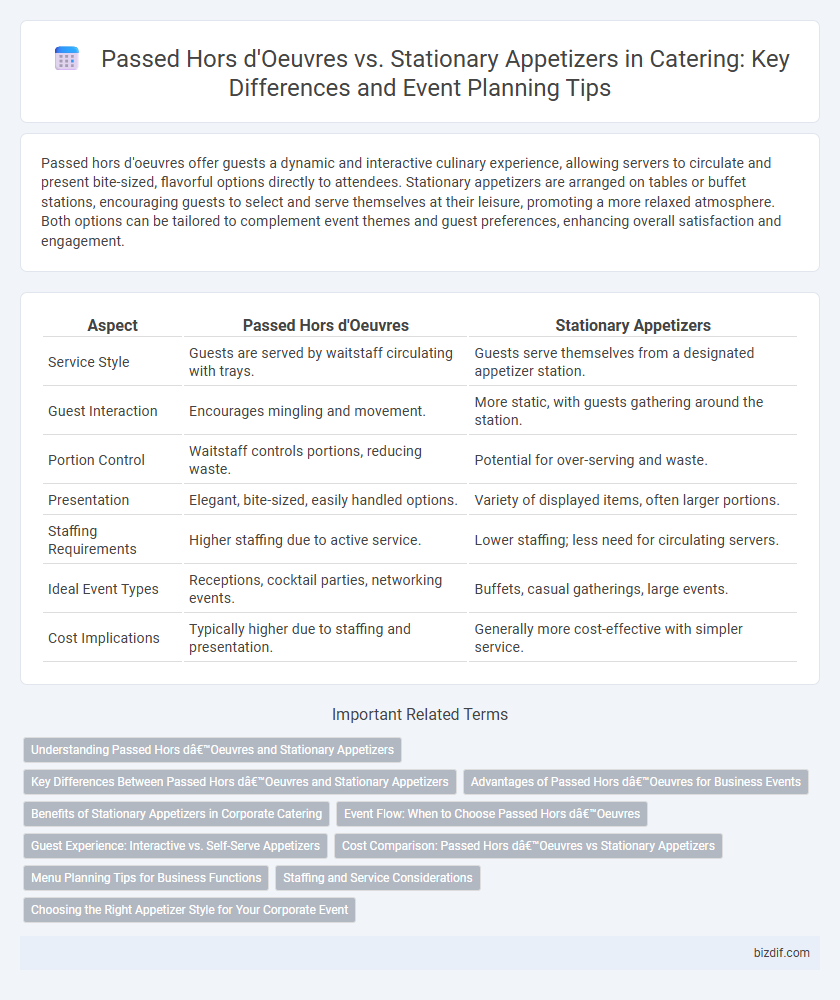Passed hors d'oeuvres offer guests a dynamic and interactive culinary experience, allowing servers to circulate and present bite-sized, flavorful options directly to attendees. Stationary appetizers are arranged on tables or buffet stations, encouraging guests to select and serve themselves at their leisure, promoting a more relaxed atmosphere. Both options can be tailored to complement event themes and guest preferences, enhancing overall satisfaction and engagement.
Table of Comparison
| Aspect | Passed Hors d'Oeuvres | Stationary Appetizers |
|---|---|---|
| Service Style | Guests are served by waitstaff circulating with trays. | Guests serve themselves from a designated appetizer station. |
| Guest Interaction | Encourages mingling and movement. | More static, with guests gathering around the station. |
| Portion Control | Waitstaff controls portions, reducing waste. | Potential for over-serving and waste. |
| Presentation | Elegant, bite-sized, easily handled options. | Variety of displayed items, often larger portions. |
| Staffing Requirements | Higher staffing due to active service. | Lower staffing; less need for circulating servers. |
| Ideal Event Types | Receptions, cocktail parties, networking events. | Buffets, casual gatherings, large events. |
| Cost Implications | Typically higher due to staffing and presentation. | Generally more cost-effective with simpler service. |
Understanding Passed Hors d’Oeuvres and Stationary Appetizers
Passed hors d'oeuvres offer guests bite-sized, easy-to-eat options served by waitstaff moving through the event space, promoting social interaction and convenience. Stationary appetizers are arranged on tables or buffet stations, allowing guests to choose items at their own pace, ideal for relaxed or self-service settings. Understanding the distinction helps caterers tailor service styles to event flow, guest preferences, and venue logistics.
Key Differences Between Passed Hors d’Oeuvres and Stationary Appetizers
Passed hors d'oeuvres are individually served by waitstaff, offering guests a dynamic and interactive dining experience, while stationary appetizers are displayed on a buffet or table for self-service, encouraging guests to choose at their leisure. Passed hors d'oeuvres enhance social mingling and portion control, whereas stationary appetizers accommodate larger crowds with diverse options and ease of access. The choice between the two depends on event style, guest interaction, and logistical considerations in catering services.
Advantages of Passed Hors d’Oeuvres for Business Events
Passed hors d'oeuvres enhance business events by encouraging guest interaction and networking through easy mobility and accessibility. They offer a sophisticated presentation that keeps the atmosphere dynamic, allowing attendees to mingle and engage without interruptions. The continuous flow of fresh, varied bite-sized options also ensures a memorable culinary experience that can elevate brand perception.
Benefits of Stationary Appetizers in Corporate Catering
Stationary appetizers enhance corporate catering by offering a consistent, visually appealing display that encourages guest engagement and networking. These appetizers allow for easy portion control and reduce the need for constant replenishment, ensuring efficient service throughout the event. Their fixed placement creates a seamless flow, minimizing disruption and allowing guests to enjoy conversations without waitstaff interruptions.
Event Flow: When to Choose Passed Hors d’Oeuvres
Passed hors d'oeuvres are ideal for events requiring fluid guest movement and social interaction, such as cocktail parties or networking receptions, allowing attendees to enjoy bite-sized treats without pausing at a station. Stationary appetizers work best when guests are encouraged to gather and linger in specific areas, promoting conversation around a buffet or tasting station. Choosing passed hors d'oeuvres enhances event flow by minimizing congestion and keeping guests engaged while moving through the venue.
Guest Experience: Interactive vs. Self-Serve Appetizers
Passed hors d'oeuvres create an interactive guest experience by allowing servers to circulate and offer personalized selections, fostering social engagement and immediate enjoyment. Stationary appetizers provide a self-serve option where guests can choose at their own pace, promoting convenience and variety without interruption. Both styles enhance event dynamics, with passed hors d'oeuvres encouraging interaction and stationary displays supporting casual mingling.
Cost Comparison: Passed Hors d’Oeuvres vs Stationary Appetizers
Passed hors d'oeuvres typically involve higher labor costs due to the need for servers to circulate and present each item individually, increasing overall catering expenses. In contrast, stationary appetizers reduce staffing requirements as guests serve themselves from set displays, resulting in lower operational costs. Budget-conscious event planners often prefer stationary appetizers to maximize variety and minimize labor expenditures without compromising guest experience.
Menu Planning Tips for Business Functions
Passed hors d'oeuvres create an interactive dining experience that encourages guests to mingle, while stationary appetizers allow for a more structured presentation and easy access. When planning menus for business functions, consider the event's size and flow; passed hors d'oeuvres work well for networking events with standing guests, whereas stationary appetizers suit seated meetings or conferences. Incorporate a mix of dietary options and flavor profiles to accommodate diverse preferences and enhance guest satisfaction.
Staffing and Service Considerations
Passed hors d'oeuvres require more staff for efficient service, as servers circulate among guests offering bite-sized, edible portions, ensuring freshness and interaction. Stationary appetizers demand fewer servers but necessitate strategic placement to prevent crowding and maintain replenishment throughout the event. Staffing levels should align with event size and guest flow to optimize service quality and minimize wait times.
Choosing the Right Appetizer Style for Your Corporate Event
Passed hors d'oeuvres create a dynamic dining experience by encouraging guest interaction and allowing servers to offer a variety of bite-sized options throughout the event, enhancing social engagement. Stationary appetizers, displayed on buffet tables or stations, provide guests with the freedom to choose at their own pace, ideal for events with larger crowds or casual mingling. Selecting the right appetizer style depends on the event's atmosphere, guest preferences, and flow; passed hors d'oeuvres suit formal, high-energy settings, while stationary appetizers work well for relaxed, self-paced networking.
Passed hors d'oeuvres vs stationary appetizers Infographic

 bizdif.com
bizdif.com